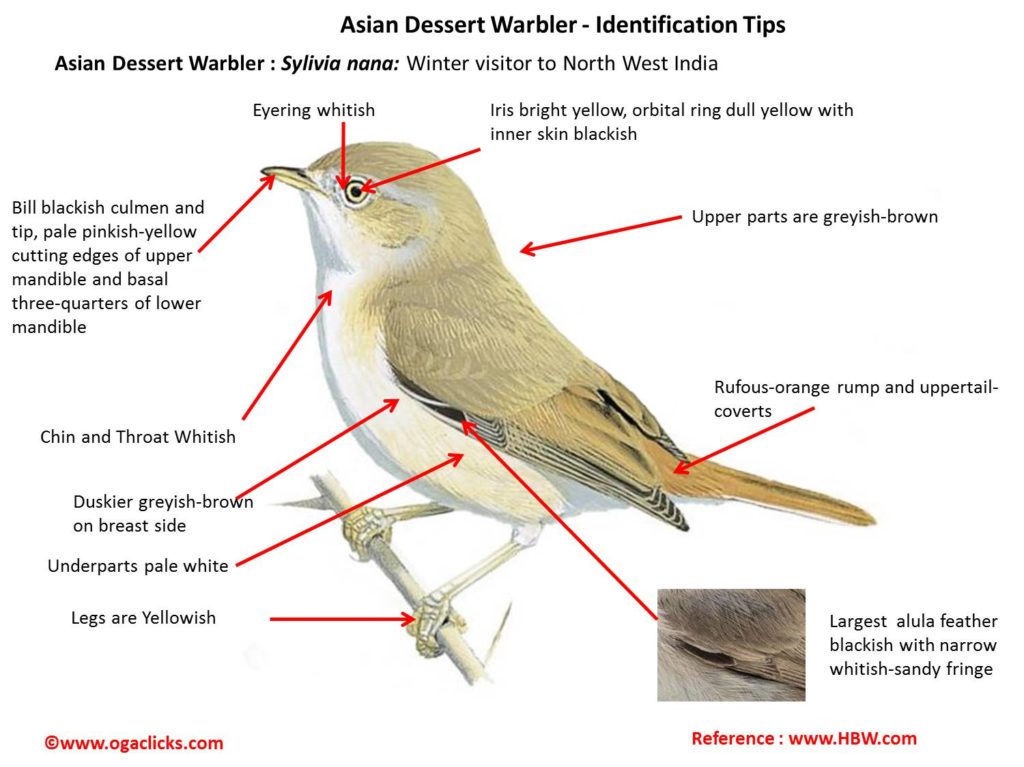Desert Warbler

Asian Desert Warbler Sylvia nana
Etymology :
- Sylvia : Latin word for “woodland sprite, little bird, warbler “
- Nana : Latin word for “dwarf”
Vernacular Name : Guj: Rana fudki, Ran sweth kanth, Mar: Valvanti Vatvatya
Distribution inIndia: Winter Visitor in North West India.
Description: Size:11.5cm.It is a small and compact, rather short-tailed warbler with relatively short wings. The nominate race in breeding is drab greyish-brown above, with distinct rufous-orange rump and uppertail-coverts; innermost tertials rufous-brown with blackish shaft area, ill-defined greyish-sandy to sandy-orange fringes; rest of remiges centered blackish-brown, fringes creating sandy-orange wing panel; upperwing-coverts brownish-grey, fringed sandy grey; largest alula feather blackish with narrow whitish-sandy fringe, fringe broader on middle feather and broadest on smallest one; tail pattern distinctive, outermost feather largely white, adjacent one with blackish center, broad white fringe on outer web and large edge on inner web, central feather pair rufous-orange with blackish shaft area, narrow sandy fringes; throat and underparts whitish, buffier on flanks and vent, duskier greyish-brown on breast side; iris bright yellow, orbital ring dull yellow with inner skin blackish, eyering whitish; bill with blackish culmen and tip, pale pinkish-yellow cutting edges of upper mandible and basal three-quarters of lower mandible; legs yellowish. Non-breeding plumage is as breeding, but with colder grey upperparts, whiter underparts. Both the sexes are similar.
Habitat : It is found in steppe-desert and semi-desert areas, low scrub and grasses, usually in sandy terrain, less frequently on stony soils. During non-breeding times found in wadis and open areas with scattered bushy acacias and scrub and low halophytic vegetation.
Food Habits: It eats small insects, also some seeds and berries. Invertebrate food includes adult and larval butterflies and moths, spiders , bugs , ants and beetles. It forages mainly on ground or at low height, gleans items from scrub, grasses and low bushes, or picks them directly from ground and from among roots. It follows Shrikes, Turdoides Babblers, bee-eaters and wheatears to prey on insects disturbed by them and to take advantage of early warning against predators.
Breeding Habits: They breed in Apr in Turkmenistan. They are monogamous; solitary, territorial breeder. In song flight, male rises above ground and descends in parachuting manner, bill and tail raised; also performs more horizontal, almost hovering song flight; during perched song, usually spreads and partially raises tail to show white edges and tips. The male builds “cock nests” from grass stems, twigs and leaves, lined with finer grass, fibers and down, the nest is firmly anchored above ground in low scrub. They lay a clutch of 4–6 eggs, incubation by both sexes.